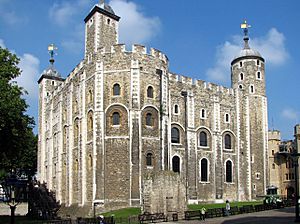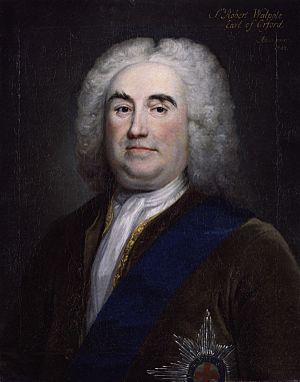Impeachment of Robert Harley, Earl of Oxford facts for kids

The Impeachment of Robert Harley, Earl of Oxford was a major legal event in Great Britain in 1715. Robert Harley, Earl of Oxford, who used to be the country's top minister, was accused of serious crimes. He was then sent to the Tower of London. The main accusations against him were about his role in the Peace of Utrecht in 1713. This treaty ended a big war called the War of the Spanish Succession.
Harley's arrest happened at the same time as a rebellion. This was the Jacobite rebellion of 1715. It was led by people who used to work with Harley. After two years in prison, a group in Parliament said Harley should either be tried or released. Harley was lucky because his enemies, the Whigs, were fighting among themselves. This division helped him. In 1717, he was found not guilty and set free. This was the last time a British head of government was impeached.
What Was the Impeachment of Robert Harley?
Robert Harley started as a Whig, a member of one of Britain's main political parties. He became powerful in 1710. He led a Tory government, another major political party. Many people in the country were tired of the ongoing war. The Whigs, however, wanted the war to continue. The Tories won a big election in 1710. After this, Harley and another important minister, Henry St John, 1st Viscount Bolingbroke, began secret peace talks with France.
Why Was Harley in Trouble?
The main army leader, the Duke of Marlborough, was removed in late 1711. A Tory leader, the Duke of Ormonde, took his place. Ormonde was given a secret order. He was told not to fight the French while peace talks were happening. This order later caused a lot of arguments. Ormonde pulled his British troops out of the allied army during the war. The remaining allied forces then lost a big battle without the British.
The Peace Treaty and New Lords
Even with strong opposition, Harley managed to get the Peace of Utrecht approved by Parliament. To do this, he had to make a special move. He created twelve new Lords in one day. These new Lords, called Harley's Dozen, helped the Tories win the vote in the House of Lords. The House of Lords was mostly controlled by the Whigs at the time.
Who Would Be the Next King?
Another big issue in Britain was who would become the next ruler. Queen Anne of Great Britain had no children. Some people, called Hanoverian Tories, supported the German royal family. Others, called Jacobites, wanted Anne's half-brother, James III of England, to be king. James was a Catholic, which was a problem for many. Harley stayed in touch with James's supporters. He might have supported James if James had agreed to become a Protestant. But Harley generally tried to stay neutral on this issue.
When Queen Anne died in August 1714, the supporters of the German royal family succeeded. George I of Great Britain became king. King George was one of Britain's allies who felt betrayed by Harley's secret peace deal. He publicly ignored Harley when he arrived in Britain.
The Charges Against Harley
In early 1715, new elections gave the Whigs a strong majority in Parliament. They immediately started to go after those they blamed for the peace treaty. They also targeted those who had secretly tried to make James king. Ormonde and Bolingbroke quickly fled to Europe to avoid arrest. Harley was the most important person left to target. Other less important figures in the peace talks were also accused.
How the Impeachment Started
On April 13, the House of Commons formed a committee of 21 members. Their job was to investigate Harley. Important Whigs like Robert Walpole were on this committee. In Parliament, Thomas Coningsby, 1st Earl Coningsby proposed to impeach Harley. Coningsby was known for being very harsh on his political enemies. The Coningsby and Harley families had been rivals for many years. Coningsby had even falsely claimed that Harley had run away from the country. Harley's brother, Edward Harley (1664–1735), who was also an MP, denied this.
On June 10, Walpole proposed that Bolingbroke, who was absent, be charged with a very serious crime against the country. Coningsby made the same proposal against Harley. The House agreed to send the matter back to the committee. They wanted the committee to prepare the official impeachment charges. This was done on July 7, with sixteen charges against Harley. The impeachment then moved to the House of Lords. Coningsby was chosen to present the charges to the Lords. He strongly argued for Harley's conviction.
What Were the Accusations?
Most of the charges were about Harley's role in the Utrecht peace treaty. One charge criticized him for creating twelve new Lords in 1711-12. This was seen as an unusual move. He was also criticized for meeting with a Jacobite Irishman, Patrick Lawless (Jacobite). Lawless was acting as the ambassador from Spain. Harley argued that some of the things he was accused of were not his responsibility. He also said that if he was held accountable, all future top ministers could be too. On July 16, 1715, the Lords voted to imprison him while he waited for his trial. He was under house arrest for two days. Then he was moved to the Tower of London. Two weeks later, Coningsby added six more charges. He claimed Harley had given the Queen "bad advice" and secretly worked for James.
Life in the Tower

Even though the charges were very serious, Harley's rooms in the Tower were quite comfortable. This was common for noble prisoners. Despite his poor health, he was ready for whatever happened. Since the charges were so serious, Harley could have faced a very severe punishment. Outside Parliament, many writers and journalists wrote about the trial. They presented different views. While some attacked Harley, others wrote to defend him.
While in the Tower, Harley's health got worse. He suffered from rheumatism and probably also pneumonia. His wife was allowed to stay and care for him. But then she also became ill.
A month after Harley was imprisoned, his former Scottish Secretary started a rebellion. He raised the flag of the exiled James in Scotland. This Jacobite rebellion spread from Scotland to Northern England. Other planned uprisings in southern England and Ireland were stopped by arrests. Two battles in Scotland and England slowed down the Jacobites' early success.
The panic caused by the rebellion led to more accusations against Harley. People thought he was involved in the uprising. However, this might have saved his life. It caused a long delay in his trial. The government had to focus on dealing with the rebellion first. By early 1716, the rebellion was defeated. Some of its leaders were also held in the Tower at the same time as Harley. Some of them were even executed there. But the fact that Harley was already in prison saved him from being accused of actively joining the rebellion.
Harley remained calm and thoughtful about his situation. Around this time, he wrote to his wife, who was living outside the Tower. He said he was ready to be "easy under any confinement." He added that he expected no special favors. He would do nothing to gain his freedom that would not be fitting for an English gentleman. He promised, "I will go out of this place with the same honor and innocence as I came into it."
How Harley Got Free

In April 1717, the Whig leaders, who were now very powerful, had a big disagreement. Charles Townshend, 2nd Viscount Townshend was removed from the government. This happened after a power struggle with James Stanhope, 1st Earl Stanhope. His friend and brother-in-law, Robert Walpole, resigned along with his supporters. This started a major division among the Whigs. Walpole now tried to get support from the Tories. He wanted to build a strong opposition to the government.
To stop this, the government Whigs tried to get Harley to promise good behavior in the future. In return, they would release him. But Harley refused. He felt that accepting this offer would mean he was admitting guilt.
Political Fights Help Harley
In May 1717, Harley's supporters proposed that he should either be tried or released. Walpole was still on the committee investigating Harley's case. He now told Harley's friend, William Bromley (Speaker), that he would work to stop the impeachment. Another supporter of Harley, Simon Harcourt, 1st Viscount Harcourt, suggested that the House should first look at the most serious charge. This was the charge of a crime against the country. This surprised the government. They had not prepared any evidence for this specific charge.
The Trial That Never Happened
By the trial date of June 24, the government was not ready to present its case. Harcourt then proposed that Harley should be released. This led to long debates in both the Lords and the Commons. In the Commons, a Whig named Sir Thomas Miller, 3rd Baronet demanded that Harley be punished. He said Harley had abandoned the Catalans, who were defeated without British help. In his last speech in Parliament, the Duke of Marlborough, who had been ill, voted against Harley. However, the Lords decided to find Harley not guilty on July 1. He was then released.
What Happened Next?
King George showed his feelings by immediately banning Harley from visiting the royal court. Harley mostly left political life. He spent his time on his artistic and literary interests until he died in 1724. Later, Walpole himself faced threats of impeachment. But this never happened. Harley was the last British chief minister to be impeached.
Alexander Pope, a writer who supported Harley, later wrote a poem. It mentioned Harley's case. The poem talks about a politician's downfall and includes the line "The House impeach him, Coningsby harangues."

